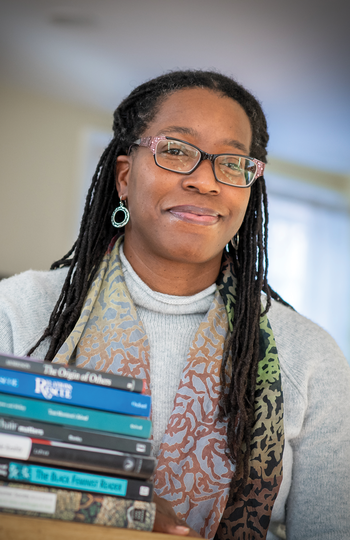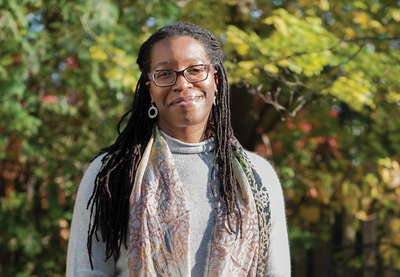As Professor of History and Radcliffe Alumnae Professor at Harvard University, Tiya Miles spends much of her time thinking, learning and teaching about how humanity’s various histories come together and influence one another. Her American Book Award-winning book, The Dawn of Detroit: A Chronicle of Slavery and Freedom in the City of Straits (2017), is a prime example of such exploration, particularly as it concerns the intertwined histories of African Americans and Native nations to create the United States we know today. Miles, a 2011 MacArthur Foundation Fellow, shared more of these histories with Teaching Tolerance, and we’re excited to share them with you.
What led you to explore the intersections between African American and Indigenous American experiences, particularly Cherokee?
I took my first African American studies course as an undergraduate. It was a literature survey that included slave narratives, and it completely opened my intellectual world. I will never forget the sense of sadness, exhilaration and conviction I felt after finishing Harriet Jacobs’ narrative, Incidents in the Life of a Slave Girl. That reading experience led me down this scholarly path. I immersed myself in Afro-American studies in college even as I became pointedly aware through meeting my spouse, who is Aaniiih-Gros Ventre/Assiniboine, that the Black experience was not the only story or even the central story of subjugation and resilience in this country.
By the time I entered a doctoral program in American studies, I knew that I wanted to study Black life and Native life in tandem and with particular attention to women and gender. When the time came to develop a dissertation topic, I learned, to my deep disappointment, that much of African American and Native American intertwined history threaded through slavery, oppression and the beautiful-yet-painful efforts that individuals and communities made to heal from the past. I chose to study slavery in the Cherokee Nation in depth after engaging in a research process that revealed the breadth and complexity of Cherokee-Black interactions and, importantly, a rich source base of documentary records that could help me to better understand this facet of Native American and African American historical life.
Teaching about Native American and African American intersections introduces our students to a fundamental set of realities.
Why is it important to consider these intersections when teaching and learning about American history in K–12 schools?
We study history and teach history for the same reasons: to gather knowledge about the human condition, to encourage empathy and to shine a light on the “truths” (or as close as we can come to them) of the past for the sake of understanding, as well as guiding, our actions in the present and future. Teaching about Native American and African American intersections introduces our students to a fundamental set of realities: that history is multiple and not singular; that human action entails goodness and inclusion as well as exploitation and exclusion; that groups of people change themselves and one another through interaction; and that societies have faced great wrongs and struggled in complex ways to survive and re-establish moral ground.
In particular, why is it important when it comes to teaching and learning about American slavery?
Native Americans were important historical actors in this long chapter of American history—both as the targets of slaving for approximately 200 years (and longer when mixed-race Afro-Native enslaved people who would be designated as “Negro” in planter records are included in this timeline) and as slaveholders of African-descended people for approximately 70 years.
Too often, the history of U.S. slavery is presented as change over time playing out across a binary set of racialized positions (white masters/Black slaves). The glaring omission in this limited paradigm is the crucial presence of Indigenous people, who were enslaved early in American colonial history, were enslaved by the tens of thousands, suffered great losses and harm, and fought against their subjugation. The Native story runs parallel to the African story, in some areas precedes it and often intersects with it. To omit this fact is to underserve our students, who deserve to be introduced to the whole “truth” as best as we can discern and reconstruct it.
One challenge educators may face is teaching about the two sides of Indigenous slavery and the fact that some Indigenous people were also enslavers. How do you recommend that educators help students make sense of this complexity?
This is indeed a challenging task, especially given concerns that some educators may feel about pre-existing stereotypes of Native Americans (as “savage”) and about exposing historically oppressed and marginalized groups to further scrutiny. However, no population is exempt from the complexities of being human or the complexities of organizing societies that conceive and commit atrocities. It would be irresponsible, of course, to characterize all or most Native people as chattel slaveholders (when a small percentage of very influential people in a handful of Southern nations actually owned Blacks). It would be equally irresponsible to ignore the decisions that some indigenous individuals and governments made to buy and sell Black people as property and to legalize exclusion through slave codes and Black codes.
We tell this story responsibly by showing students as many sides of it as we can, by articulating the contexts of colonialism and racial hierarchy, and by encouraging empathetic as well as critical readings. Native American history (and African American history) can and should be treated with the same degree of nuance with which we (now, I hope) treat U.S. history. To deny the ability of any people to do terrible things, to harm others or to fail expressed ideals would be a denial of their membership in the human family.
Your work also delves into various ways in which Black and Native communities came together in solidarity in the past. What themes have you gleaned from those relationships, and what can young people learn from these themes?

The dominant theme in these relationships is their unpredictable nature, and this is an aspect of Native-Black relations and also of historical relations writ large that I think students should understand. As people in the past grappled with change in often very difficult times, they struggled to make decisions, form relationships, shape social structures and solve problems. Within this complex picture, Native Americans and African Americans sometimes joined forces, identifying common values or threats. At other times, they disagreed, competed with and fought one another.
When these groups shared geographical and social space, all kinds of results followed: from the formation of devoted families to the birthing of new ideas and combined cultural practices, to the organization of resistance movements, to the shaping of sharp animosities and hostilities. This history can reveal to students the dense complexity of the past as well as human interrelations. It can also show students that no groups are naturally aligned due to “common” characteristics like race or skin color. Alliances are forged, not given.
What are some present-day implications of these Black-Native intersections that educators might explore in their classrooms?
The most obvious present-day implication is the existence of the U.S. as a political powerhouse, a global force among nations. The U.S. exists only because of foundational expropriation of North American indigenous lands. The American colonies and American state established and cemented economic and, hence, political strength as a direct result of legalized, systemized and culturally sanctioned slavery on this land—that is to say, the exploitation of Indigenous American and African-descended people’s mental, physical and reproductive labor.
Another contemporary implication that my students have found fascinating is the cultural exchange and borrowing that has led to a rich musical inheritance, particularly in the realms of hip-hop, jazz and roots music, as in the work of Muskogee poet and saxophonist Joy Harjo and African American folk singer Amythyst Kiah.
For educators who are unsure of how to incorporate these intersecting histories into their curricula, where do you suggest they start?
I would suggest starting with firsthand accounts and personal narratives. In my experience, the immediacy and vibrancy of these accounts grips the interest of students and invites questions about overlap, comparison, intersection and complexity. There are several excellent and accessible collections of WPA slave narratives to consult, both in print and digital formats. The collection Black Indian Slave Narratives, edited by Patrick Minges (Blair), features narratives that reflect Black and Native intersections. A collection titled The Oklahoma WPA Ex-Slave Narratives edited by T. Lindsay Baker and Julie P. Baker (University of Oklahoma Press) also features relevant narratives. Similarly, the WPA Indian Pioneer Papers (published in thematic volumes and also available in library manuscript and microfilm collections) highlight Native experiences of removal and building new lives in Oklahoma that included interactions across lines of race, class, nationality and color.
In the course of her research,
Dr. Miles uncovered a number of unknown stories about what she calls “the mosaic of African American and Native American intersectional lives.” In her books The House on Diamond Hill: A Cherokee Plantation Story and The Cherokee Rose, Miles shares elements of that mosaic. She retells some of that history here for middle grades readers, with editorial support from TT Senior Editor Julia Delacroix.
Diamond Hill was the name of a plantation founded by James Vann, a Cherokee businessman and political leader. The Black community at Diamond Hill was a diverse group, and it included a lot of people with different experiences and backgrounds. Here are brief histories of three people who lived and died at Diamond Hill.
James Vann was the owner of Diamond Hill. The son of a Cherokee woman and a Scottish trader, James inherited Cherokee citizenship from his mother and valuable property from his father. He controlled nearly 1,000 acres of land bordered by the Conasauga River in what is now north Georgia.
In 1804 and 1805, a lot of work happened on that land. A large two-story log home was built. Fields of wheat and corn were planted. Several herds of cattle were bred and cared for. A mill for grinding grain and a still for making whiskey were built. And a store was built and opened. But James didn’t do this work on Diamond Hill himself. He enslaved people to do the work for him.
Caty was an Afro-Cherokee woman enslaved at Diamond Hill. She had been born in the Cherokee Nation and spoke the Cherokee language. Caty’s parents had been enslaved in the Cherokee Nation, too. Because her childhood was so influenced by Cherokee culture, nearby missionaries said Caty was “like the Indians themselves.” Peggy Scott Vann, James’ wife and a Cherokee slaveholder on the plantation, thought of Caty as a close friend. She took care of Caty in the last days of her life, and she wanted to have Caty buried in a special place. But Peggy never freed her friend.
Isaac was also Afro-Cherokee and was also enslaved at Diamond Hill. He was an accomplished fiddler. Sometimes, when he was ordered to, he played at the Vanns’ parties. He was also good with languages—so good that the missionaries asked him to translate for Cherokees visiting the neighboring mission. He agreed, but he traded this work for reading instruction. Seeking to escape enslavement, Isaac ran away from Diamond Hill several times. The last time he was caught, James had him killed for running away.
In 1809, 583 Black people were enslaved in the Cherokee Nation. The Vann family enslaved 115 of them, about one out of every five.
Diamond Hill was the site of the largest Black community in what is now north Georgia. Enslaved Black people from nearby plantations and free Black people from the area often stayed there. In this place, mostly isolated from white Americans, Black people, Indigenous people and Afro-Native people went about their daily lives, raised families, suffered abuses and constantly looked for moments of dignity and chances for freedom.

